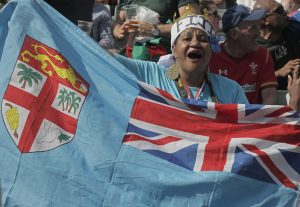Modern Fiji is 50 years old, having regained its independence from the British on October 10, 1970. Fiji was not conquered by Britain, but became a British colony via an agreement called a Deed of Cession. In a related development, this little piece of decolonization in the South Pacific did not resemble its counterparts elsewhere, when the lowering of the colonial flag constituted victory for a nationalist movement. In Fiji, by contrast, there was strong sentiment among the indigenous population to remain under British protection.
The reason for reticence on the part of the indigenous Fijians went to the heart of Fiji’s central and overriding demographic and political facts: the population was divided between the indigenous people, who could claim occupation of their land going back 3,000 years, and Fijians of Indian heritage, who were mostly the descendants of plantation laborers introduced between 1879 and 1916 to work the great sugar estates of the Colonial Sugar Refining Company. As for the differences between these two communities, they were described in 1960 by a British undersecretary at the Colonial Office, Julian Amery, in this way:
The Fijians and Indians are more distinct as communities than Jews and Arabs in Palestine, Greeks and Turks in Cyprus, or Europeans and Bantu in South and Central Africa. Intermarriage, business associations, even personal friendships are rare.
This description probably overstated the case, but there was no doubt that Fiji was the polar opposite of Hawaii, where generations of inter-marriage produced a general tolerance. Fiji was split along lines of racial identity and that divergence lay at the center of the country’s tortured politics.
The fundamental question that has faced the people of Fiji since independence is: Who should hold power?

































